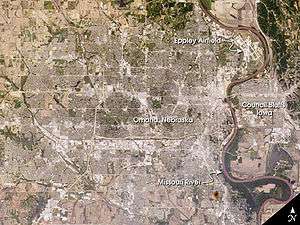Omaha–Council Bluffs metropolitan area
| Omaha metro | |
|---|---|
| Omaha–Council Bluffs metropolitan area | |
 | |
| Coordinates: 41°15′35″N 95°55′18″W / 41.2597°N 95.9217°W | |
| Country | United States |
| State(s) | |
| Largest city | Omaha |
| Other cities | |
| Area | |
| • Total | 4,407 sq mi (11,410 km2) |
| Population | |
| • Total | 915,000 (2,015 estimate) |
| • Rank | 59th in the U.S. |
| • Density | 196/sq mi (76/km2) |
The Omaha–Council Bluffs metropolitan area is a metropolitan area comprising the cities of Omaha, Nebraska, and Council Bluffs, Iowa, and surrounding areas. The area has a population of 915,312 (2015).[1] The metropolitan area, as defined by the Office of Management and Budget, consists of eight counties – five in Nebraska and three in Iowa.[2][3] The area is locally referred to as "the Metro Area", "the Metro", or simply "Omaha". Three of the counties have large urban areas; the other five counties consist primarily of rural communities, most of which have populations of 1,000 or less.
Historical definitions and populations
| Historical population | |||
|---|---|---|---|
| Census | Pop. | %± | |
| 1950 | 366,395 | — | |
| 1960 | 457,873 | 25.0% | |
| 1970 | 540,142 | 18.0% | |
| 1980 | 585,122 | 8.3% | |
| 1990 | 618,262 | 5.7% | |
| 2000 | 767,041 | 24.1% | |
| 2010 | 865,350 | 12.8% | |
| Est. 2015 | 915,312 | 5.8% | |
| [4] | |||

Standard definitions for United States metropolitan areas were created in 1949; the first census which had metropolitan area data was the 1950 census. At that time, the Omaha–Council Bluffs metropolitan area comprised three counties: Douglas and Sarpy in Nebraska, and Pottawattamie in Iowa. No additional counties were added to the metropolitan area until 1983, when Washington County, Nebraska was added. Cass County, Nebraska was added in 1993; Saunders County in Nebraska and Harrison and Mills counties in Iowa became part of the Omaha–Council Bluffs metropolitan area in 2003.
The 2003 revision to metropolitan area definitions was accompanied by the creation of micropolitan areas and Combined Statistical Areas. Fremont, in Dodge County, Nebraska, was designated a micropolitan area. The Omaha–Council Bluffs–Fremont combined statistical area has a population of 858,720 (2006 estimate).[5]
Components of the Omaha–Council Bluffs metropolitan area
Counties
| County | State | 2015 estimate | 2010 Census | Change |
|---|---|---|---|---|
| Cass | Nebraska | 25,512 | 25,241 | +1.07%[6] |
| Douglas | Nebraska | 550,064 | 517,110 | +6.37%[7] |
| Sarpy | Nebraska | 175,692 | 158,840 | +10.61%[8] |
| Saunders | Nebraska | 21,016 | 20,780 | +1.14%[9] |
| Washington | Nebraska | 20,248 | 20,234 | +0.07%[10] |
| Harrison | Iowa | 14,265 | 14,928 | −4.44%[11] |
| Mills | Iowa | 14,844 | 15,049 | −1.36%[12] |
| Pottawattamie | Iowa | 93,671 | 93,158 | +0.55%[13] |
Cities
Primary city

- Omaha – 408,958 inhabitants (2010)
Cities of 10,000 people or more
- Council Bluffs, Iowa - 62,230 inhabitants (2010)
- Bellevue, Nebraska – 50,137 inhabitants (2010)
- La Vista, Nebraska – 15,758 inhabitants (2010)
- Papillion, Nebraska – 18,894 inhabitants (2010)
Cities of 5,000 to 10,000 people
- Blair, Nebraska – 7,990 inhabitants
- Glenwood, Iowa – 5,269 inhabitants
- Plattsmouth, Nebraska – 6,502 inhabitants
- Ralston, Nebraska – 7,187 inhabitants
Cities of 1,000 to 5,000 people
|
|
Cities and villages with fewer than 1,000 people
|
|
Census-designated places
- Chalco, Nebraska – 10,736 inhabitants
- Offutt Air Force Base – 8,901 inhabitants
Annexations of formerly incorporated places by the City of Omaha
| Annexations by the City of Omaha | |||||
|---|---|---|---|---|---|
| Year | Former incorporated area name | ||||
| 1854 | East Omaha, Nebraska | ||||
| 1877 | Kountze Place | ||||
| 1877 | Gifford Park | ||||
| 1877 | Saratoga, Nebraska | ||||
| 1877 | Near North Side, Omaha | ||||
| 1887 | Sheelytown | ||||
| 1887 | Bemis Park | ||||
| 1915 | South Omaha, Nebraska | ||||
| 1915 | Dundee, Nebraska | ||||
| 1917 | Benson, Nebraska | ||||
| 1917 | Florence, Nebraska | ||||
| 1971 | Millard, Nebraska | ||||
| 2005 | Elkhorn, Nebraska | ||||
Notes
- ↑ Henry J. Cordes. "For the Omaha metro area, population milestone of 1 million is in sight". Retrieved March 26, 2014.
- ↑ Hunzeker, S. "Nebraska Metro & Micro Statistical Areas", Nebraska Department of Labor. Retrieved September 5, 2008.
- ↑ "May 2007 OES Metropolitan and Nonmetropolitan Area Definitions." Bureau of Labor Statistics. Retrieved September 5, 2008.
- ↑ "Metro population hits 865,350". Omaha.com. Retrieved 2011-03-06.
- ↑ Iowa Data Center. "Population Estimates and Components of Population Change for Iowa's Combined Statistical Areas (2003 Definition): 2000–2006" (PDF). Retrieved April 6, 2007.
- ↑ http://www.census.gov/quickfacts/table/PST045215/31177,31153,31155,31055,31025
- ↑ http://www.census.gov/quickfacts/table/PST045215/31177,31153,31155,31055,31025
- ↑ http://www.census.gov/quickfacts/table/PST045215/31177,31153,31155,31055,31025
- ↑ http://www.census.gov/quickfacts/table/PST045215/31177,31153,31155,31055,31025
- ↑ http://www.census.gov/quickfacts/table/PST045215/31177,31153,31155,31055,31025
- ↑ http://www.census.gov/quickfacts/table/PST045215/19085,19155,19129
- ↑ http://www.census.gov/quickfacts/table/PST045215/19085,19155,19129
- ↑ http://www.census.gov/quickfacts/table/PST045215/19085,19155,19129
External links
- Population for Iowa metropolitan areas and components, 1950 – 2000
- omaha.towncommons.com – wiki website for the Omaha–Council Bluffs metro area
Coordinates: 41°15′35″N 95°55′18″W / 41.25972°N 95.92167°W
